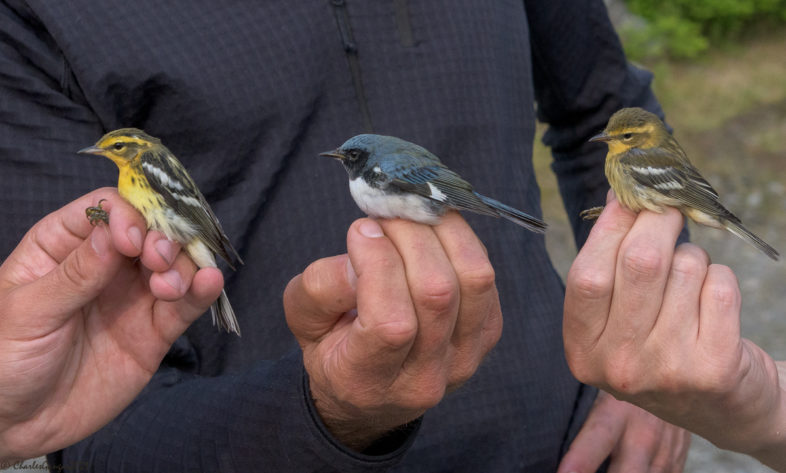
A trio of immature northern hardwoods forest warblers: from left, Blackburnian male, Black-throated Blue male, Blackburnian female. Mt. Mansfield, 4 August 2021. © Charles Gangas
Who could ever have imagined a VCE Mansfield banding session with nary a capture of Bicknell’s Thrush (BITH), White-throated Sparrow, Blackpoll Warbler, or Yellow-rumped Warbler? Not any of us, that’s for sure. Yet, our final 2021 summer visit on 3-4 August met with that very result. We certainly didn’t expect much in the way of visible or audible avian activity—the breeding season is over, most adults are laying low during their annual molt, and fall migration is barely underway. However, not to mist net a single individual of those four core breeding species, and to scarcely see or hear any on the ridgeline, was unprecedented. Thankfully, an influx of “foreigners” made up for the scarcity of locals.
The VCE team arrived in early evening to near-perfect netting conditions—warm, calm, light cloud cover—determined to improve on last week’s meager 2-day total of 19 captures. By closing time at nightfall, we had all of 2 individuals under our belt, one of which just happened to be a vociferous Northern (Yellow-shafted) Flicker, the first we’ve ever banded on the mountain. Undeterred by our skimpy haul, we took in the night sky, rolled out our sleeping bags, and anticipated a busy morning.
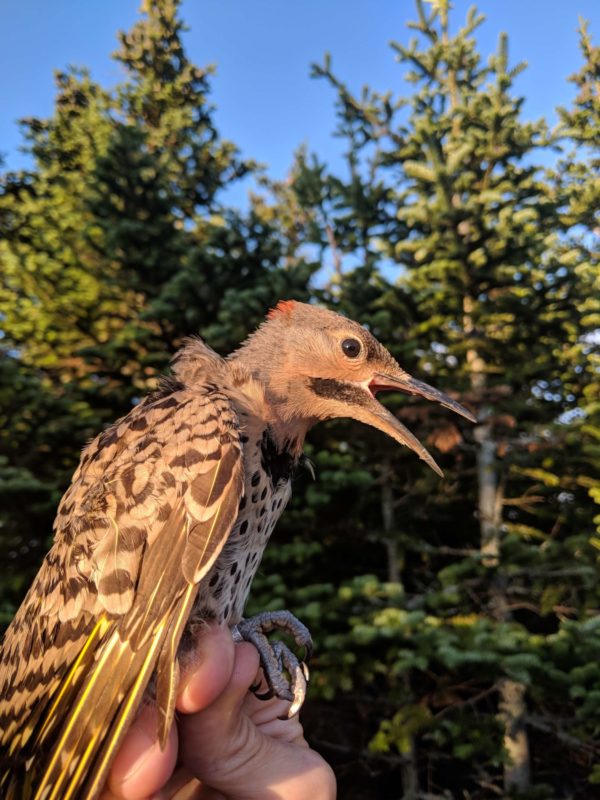
A feisty juvenile male Northern (Yellow-shafted) Flicker—the first ever banded by VCE on Mansfield—registers its disapproval at the process, 3 August 2021. © Nathaniel Sharp
Several of us were up by 4 am to open nets well before first light, in hopes of catching an overdue Northern Saw-whet Owl, but the species—which we capture in ~2 of every 3 years, especially in summers following bumper cone crops like 2020’s—eluded us. The 5 am net check came back…empty, mirroring the non-existent dawn chorus. Our spirits revived when the 6 am check yielded an adult Swainson’s Thrush and look-alike Ovenbird. The former was our only locally-breeding bird of the morning, apart from the steadfast junco parade. Activity picked up at 7:00 and was steady through net take-down 4 hours later.
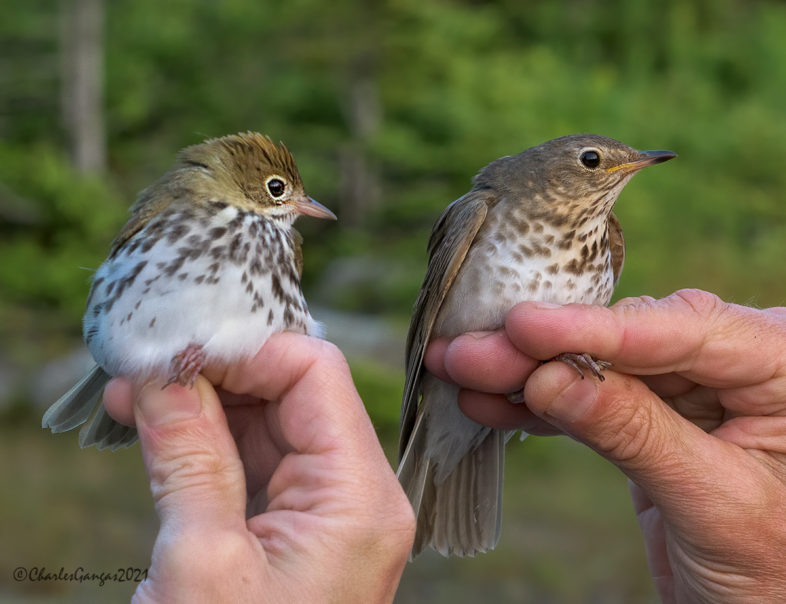
Warbler and thrush look-likes: Ovenbird (left) and Swainson’s Thrush (right). Mt. Mansfield, 4 August 2021. © Charles Gangas
The morning’s banding was notable both for its influx of non-local birds (species that don’t breed on the ridgeline itself) and the continued dearth of locally-nesting adults or young. We captured 11 individuals of six warbler species, none of them montane forest breeders; most inhabit lower-elevation forests on Mansfield and elsewhere throughout the region. Particularly surprising was the simultaneous appearance of 3 immature Blackburnian Warblers in one net and 2 Black-throated Green Warblers, which accounted for our record-setting 6th and 7th captures of the season. Juvenile Golden-crowned Kinglets continued their strong showing (we’ve now banded 15), and a Canada Warbler drew some ooohs and aaahs, as always. The only bona fide migrant was an adult female Tennessee Warbler, a boreal forest breeder that is highly unusual in actively molting its flight feathers during southward migration.
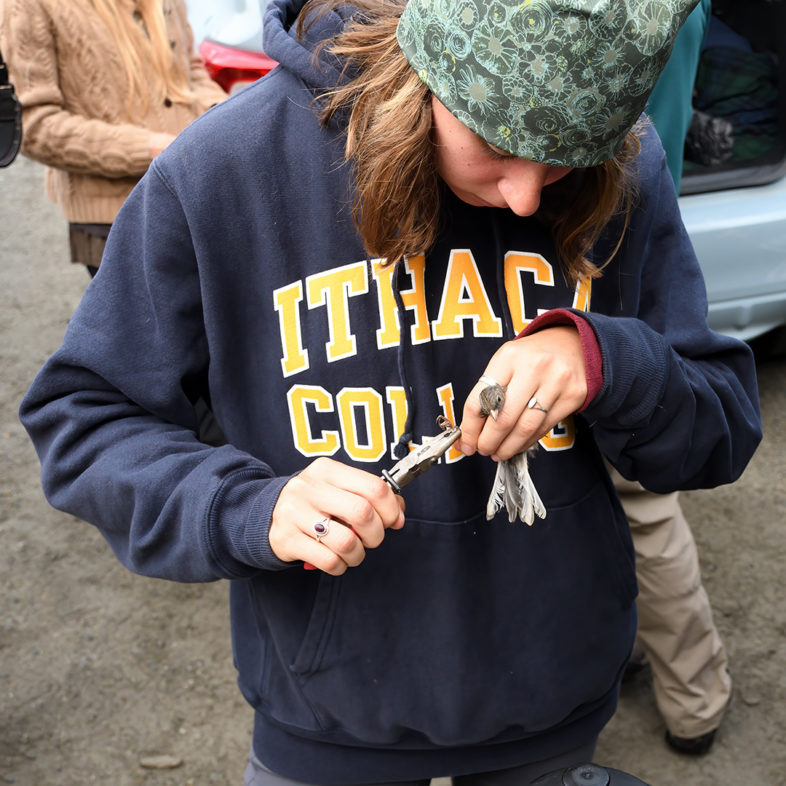
VCE summer intern Ani McMannon, a rising senior at UVM ‘s Rubenstein School of Environment and Natural Resources, bands a juvenile Dark-eyed (Slate-colored) Junco, the only locally-breeding species that appeared in “normal” numbers during our 3-4 August banding session. © Michael Sargent
The near-total absence of local breeders other than juncos in our nets is puzzling, though not alarming. Most adults are now in early or middle stages of flight feather molt, which reduces both their capacity and inclination to fly; our capture rates always decline sharply after mid-July. However, the paucity of free-flying, independent young in our nets makes much less sense. There can be little doubt that locally-fledged BITH, White-throats, and Blackpoll and Yellow-rumped (Myrtle) warblers are still present on the ridgeline. In past years, we have captured reasonable numbers, mostly young-of-the-year, at this late stage of the season. We have no evidence that fledglings disperse out of montane forests once reaching independence, though this week reconfirmed that lower-elevation species regularly disperse upslope in mid- and late summer. For now, we can only guess that the lack of local immatures may have resulted from low activity, especially any involving flying. If young birds are foraging primarily by methodical foliage gleaning or seeking arthropods on the ground, few mist net captures would be expected. That untested hypothesis, however, certainly doesn’t explain the continued solid captures of juvenile juncos!
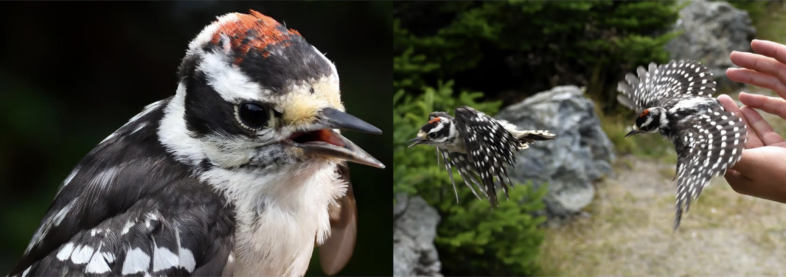
A juvenile Downy Woodpecker (note that both sexes have a red crown patch in juvenal plumage) was VCE’s final bird of the 2021 summer banding session. Mt. Mansfield, 4 August 2021. © Michael Sargent
Our final tally of 30 captures included:
Downy Woodpecker — 1 juvenile
Northern (Yellow-shafted) Flicker — 1 juvenile male, first-ever Mansfield capture
Golden-crowned Kinglet — 6 juveniles, all transitioning to first basic plumage
Swainson’s Thrush — 1 adult of unknown sex
Dark-eyed Junco (Slate-colored) — 10: 9 new (7 juveniles), 1 return male from 2020
Ovenbird — 3 immatures
Tennessee Warbler — 1 adult female in early primary molt
Blackburnian Warbler — 3 immatures
Black-throated Blue Warbler — 1 immature male
Black-throated Green Warbler — 2 immatures
Canada Warbler —1 immature female
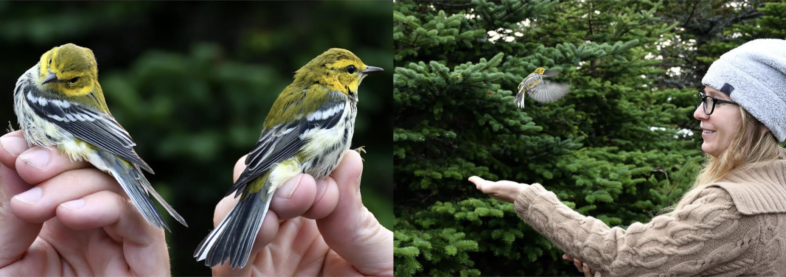
Two immature Black-throated Green Warblers (left) were among the 11 non-local warblers captured during VCE’s final summer banding session (© Michael Sargent); Angela Repella releases one (right, © Charles Gangas). Mt. Mansfield, 4 August 2021.
Our hopes of attaching an additional GPS tag or two to adult BITH went unfulfilled, leaving us “stuck” at 34 of the 40 tags we have available. While we’re very pleased overall with this sample, and enthused about the geospatial mysteries to be revealed when we recapture some—hopefully many—tagged birds next June and July, we have one more shot at affixing these tiny backpacks to BITH before they head south. We’ll return to the ridgeline in mid-September for what has become a VCE annual rite of passage. For reasons that aren’t entirely clear, BITH undergo a resurgence of activity prior to departing, as birds call and sing, move about widely, even respond to playback. Last September, we captured 4 adults that we hadn’t encountered during our summer netting—2 of them were birds banded in previous years. Hope springs eternal, and while we can’t count on deploying all 6 of our remaining GPS tags, we’re confident of adorning a few more birds with these miniature dataloggers next month.
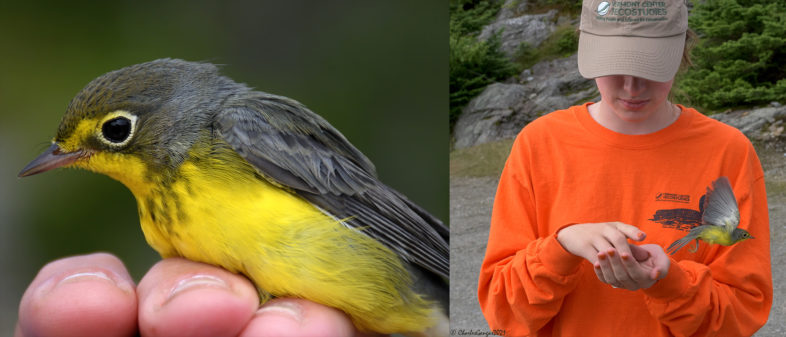
An immature female Canada Warbler , up close (left) and being released by Dory Hindinger (right). © Michael Sargent (left), Charles Gangas (right)
In the meantime, we’re grateful for the terrific help, camaraderie, and enthusiasm that VCE staff, volunteers and visitors offered during the past 10 weeks. It is amazing to reflect on the fact that our work on Mansfield has now spanned 30 years! Special thanks to our ace photographers Mike Sargent and Chuck Gangas, whose images have graced our weekly updates. Stay tuned for one more in ~6 weeks.
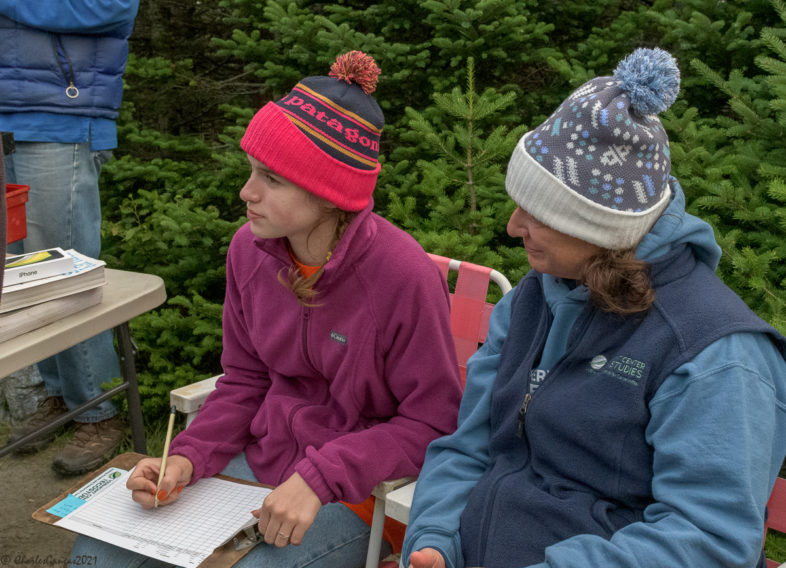
VCE’s new data recorder extraordinaire Dory Hindinger awaits word on a wing measurement or fat score while mom Susan looks on admiringly. © Charles Gangas

Thank you Chris et al for another informative season from the top of Vermont.
Thank you. Your reports and explanations from Mansfield never disappoint.